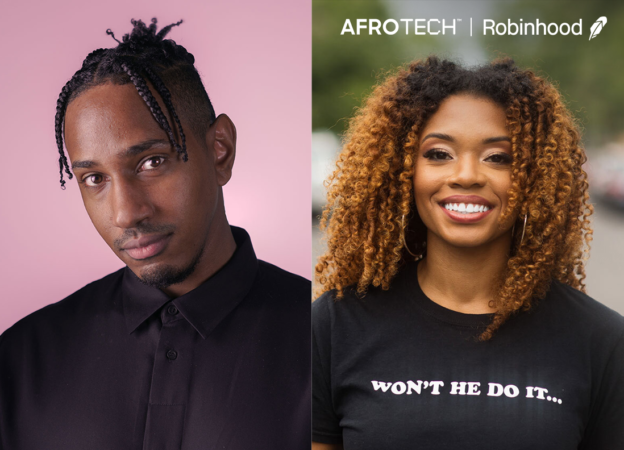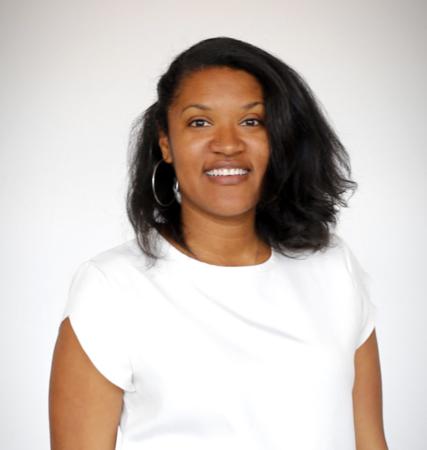A lot goes on behind the scenes at a startup in the FinTech industry. Beyond finding new ways to disrupt the financial industry, innovative startups facilitate entry into the financial markets for a new generation of investors.
One such startup is Robinhood, a FinTech company with a groundbreaking approach to investing that’s making a huge impact on the way people approach finance. Beyond being the modern person’s answer to making Wall Street moves, there’s a lot more than meets the eye. Robinhood’s mission of “democratizing finance for all” isn’t limited to its customers. After being ranked a LinkedIn Top Startup four years in a row, as well as 2021’s “Best Place to Work” by Glassdoor, it’s clear that even during the most challenging times, the company is investing in its people.
We sat down with two of Robinhood’s bright stars to learn more about their career paths, what led them to Robinhood and what it’s like behind the scenes.

Briana Richardson, Head of Market and Product Insights & Strategy — Almost two years at Robinhood
Briana Richardson’s journey began at Georgia Tech, where she graduated with a degree in chemical engineering. During her senior year, she established a tech venture that jump-started her interest in the business aspects of companies. After launching the short-lived tech venture, Richardson worked in consulting to learn the dynamics of building successful, scalable businesses before embarking on a career journey at Robinhood.
AT: Tell us about how you got your start at Robinhood.
BR: I worked at Bain & Company for three years in the Atlanta office before moving to Amsterdam, which was a great experience. While I was there, I had to learn pretty quickly to use various tool sets to drive strategic decisions. After leaving Bain, I went to Harvard Business School, got my MBA and then upon graduating I was faced with the decision to either go back into consulting or go into the tech world.
I’d already been a Robinhood customer for years and had been obsessed with it for a long time, which is how I got my introduction to trading, and I continued to follow it while I was in school. When I got the opportunity to work there, I was really excited to join a team as an MBA hire. There was a setup that allowed us to rotate through different business groups, which included developing corporate partnerships, business operations and benchmarking insights and strategy.
AT: Since joining the company, how has Robinhood fostered your career growth as a Black professional?
BR: When I first joined, we didn’t have an ERG (employee resource group) for the growing number of Black professionals. Two individuals, Lori and Alan, took the lead in founding Black Excellence (BEX) in our Lake Mary office, and I joined as the co-lead in the Menlo Park office. It has now evolved into a team of 10+ individuals who have created an environment for people to have a sense of community within the office.
I think the creation of the Black Excellence ERG has been a huge driver in my development — just having more peers that I can turn to, having a more vocal perspective and seeing more people that look like you in these town halls makes a difference.
AT: What would you say has been the most challenging part of your role?
BR: When I joined Robinhood, the team that I’m on only [consisted of] my manager. So it actually wasn’t even a team; it was a person. The most challenging thing about building something from scratch is that you have to think about how it’s going to work operationally — how you will structure the team, hire employees, communicate and get that buy-in to develop trust.
I think this is a function that has really helped us as a company. Using strategy and insights enables us to learn from the successes and challenges and elevate the voice of the customer.
AT: How would you describe diversity in the FinTech industry, and what are changes that could be made?
BR: Great question! I think there’s a people angle and then there’s the product angle. I think hiring more diverse people is something every industry struggles with, and I don’t think anyone has gotten this right, which is why the question always exists. But I do think that people have been more successful on the product side. I don’t know the numbers offhand, but I’ve read different articles around the increase of African Americans interested in finance and trading because of Robinhood or similar apps in the FinTech space. So I think there is a positive impact on diversity and equity that’s being driven by FinTech products.
AT: What’s something people might not know about life at Robinhood?
BR: One thing our leadership is always discussing is how much we care about our customers. It’s core to the mission and in everything we talk about; we take investing very seriously. I’ve never seen a company so fixated — in a positive way –—on being tied to the customer and having that be the North Star that drives the company. Robinhood’s company life is anchored in a customer-first mentality.

Daniel Belay, Brand Motion Designer — six months at Robinhood
Daniel Belay is an Ethiopian Atlanta native currently based in NYC. For the past decade, the Savannah College of Art and Design graduate has used his multidisciplinary skill set of design and motion to create experiences across multiple industries before landing his role at Robinhood.
AT: Can you talk about what you currently do at Robinhood? And what led you here?
DB: I got into design by luck! Originally I was going to pursue computer science, but a series of random events led me to where I was supposed to be — motion design. I was working as a motion designer for a lot of different places — in agencies, design studios, I worked in broadcast. It’s been a good 10 years. But there is always this question of “What’s my North Star? What am I doing this for?” And I was at a place where I was asking myself what would be the ideal to put my passion [for design] toward doing something that I believed in.
I started investing six years ago, before I even started working at Robinhood. I knew then how important it was to start taking this new approach to investing. My parents came to the U.S. from Ethiopia, so they started investing at the same time I did. No one tells you how important it is; these aren’t conversations we had when we were growing up. So I knew then that if more of us were going to start thinking about building long-term generational wealth, there needed to be more opportunities for us to learn about this.
So really, getting a job at Robinhood was kind of a dream come true.
AT: You joined the company in the middle of a pandemic. What challenges did you face onboarding, and how did the Robinhood culture make it possible to bring your authentic self to the virtual workspace?
DB: When I started, I was a little bit worried about what the work culture would look like, since I’d be working remotely. Obviously you don’t have the same opportunities to meet people as you would in a physical office, so I wasn’t sure how I would integrate into the company culture under this new environment. But that actually hasn’t been a problem at all; it’s been easy to network and connect with my team virtually.
Robinhood has ERGs, a very open community and a lot of transparency that I wasn’t used to, coming from a different industry. The design team is amazing and makes sure to create opportunities to bond and connect with each other and just have conversations, share concerns and accolades.
At Robinhood, there’s an ERG for everything. I’m thinking in particular about Black Excellence, but there are so many other ones, too — for BIPOCs, for designers, for everything. They even make it possible to get together and have events. They’re all online for now, but you really don’t feel like you’re missing out on anything. There’s always a way to connect. The ERGs are great at supporting each other, and there is always room for people who want to join and be a part of any group, which makes it easy to get support from people who are allies.
AT: What would you say has been the most challenging part of your role?
DB: I don’t know if I would say it’s specifically a challenge, but coming from the broadcast and advertising industry, which can be hierarchical, having a different approach to the way we work has definitely changed my way of thinking. The work culture here is very flat, as in there’s a lot of transparency and not the traditional hierarchical structure to the working environment. I guess I’d say that the challenge is that if you want to start an initiative or something, it’s on you to make it happen. But the great thing about that is that if you feel inspired, it’s a great environment where you can launch initiatives very easily. And there is a lot of direct communication, so you have a ton of support to make those initiatives happen.
AT: What’s something people might not know about life at Robinhood?
DB: It’s just amazing how thoughtful the culture is here. It’s a very open environment. There are a lot of really talented people here who really respect each other and respect your craft. They take the same care and love [for customers] and apply that internally. We really feel that here. A lot of times, people don’t realize that doing work you love doesn’t have to be a sacrifice. You can have a great working environment [and] build great relationships –– you really can have it all. But finding the right fit in the right company culture is so important.
AT: What advice would you give Black creative professionals interested in carving a lane for themselves in tech?
DB: Build relationships, find a mentor, be intentional. You’d be surprised how many people are willing to help.
Robinhood is committed to lowering the barriers for millions to participate in financial markets. Learn more about the company’s mission to democratize finance for all, and check out some of the opportunities if you are interested in joining the team.
This editorial is brought to you in collaboration with Robinhood. Blavity Inc. is not affiliated with Robinhood Markets, Inc.


